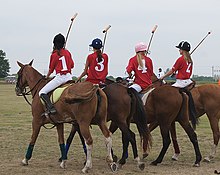Common Techniques and Practices
There are two basic defense techniques allowed in polo. The hook, or hooking, is when a player uses their mallet to block or interfere with an opponent's swing by hooking the mallet of the other player with their own mallet. A player may hook only if is he is on the side where the swing is being made or directly in front or behind an opponent. A foul is awarded for any hooking that does not fit this stipulation. For example, a player cannot reach over the mount of another player to hook their mallet, and this would be considered a penalty.The other defense technique is the bump, or ride-off. This is similar to a body-check in hockey. It is used to break an opposing player's concentration, move him off the line of the ball, or spoil his shot. A ride-off is when one player rides his pony next to an opponent to lead him away from the ball. This is only allowed when the angle of collision is not greater than 45 degrees.
Polo ponies
Polo training generally begins at age three and lasts from about six months to two years. Most horses reach full physical maturity at about age five, and ponies are at their peak of athleticism and training at around age 6 or 7. However, without any accidents, polo ponies may have the ability to play until they are 18 to 20 years of age.
More than one pony per player is needed in order to allow tired mounts to be changed for fresh mounts between or even during chukkas. There are typically between 4 to 8 ponies per player. The group of ponies for a given player is commonly referred to as a "string of polo ponies", with a minimum of 2 or 3 ponies in Low Goal matches (with ponies being rested for at least a chukker before reuse), 4 or more ponies for Medium Goal matches (at least one per chukker), many more for the highest levels of competition.
Players
Each team consists of four mounted players, which can be mixed teams of both men and women.Each position assigned to a player has certain responsibilities:
- Number One is the most offense-oriented position on the field. The Number One position generally covers the opposing team's Number Four.
- Number Two has an important role in offense, either running through and scoring themselves, or passing to the Number One and getting in behind them. Defensively, they will cover the opposing team's Number Three, generally the other team's best player. Given the difficulty of this position, it is not uncommon for the best player on the team to play Number Two so long as another strong player is available to play Three.
- Number Three is the tactical leader and must be a long powerful hitter to feed balls to Number Two and Number One as well as maintaining a solid defense. The best player on the team is usually the Number Three player, usually wielding the highest handicap.
- Number Four is the primary defense player. They can move anywhere on the field, but they usually try to prevent scoring. The emphasis on defense by the Number Four allows the Number Three to attempt more offensive plays, since they know that they will be covered if they lose the ball.
www.sportalerts.blogspot.com
 11:11 PM
11:11 PM
 MUHAMMAD USMAN AWAN
MUHAMMAD USMAN AWAN




 Posted in:
Posted in: 






0 comments:
Post a Comment